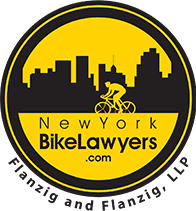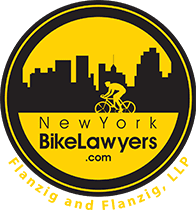NY Times Answers to Biking Questions
Merging Cars and Bikes
Q. On the left side of Eighth Avenue, through many blocks of Midtown, there is a bike lane painted green. Next to it is a lane usually occupied by parked vehicles, and then a traffic lane. On the side streets that allow a left turn, a short angled lane steers drivers in the traffic lane over to the left for the turn. In doing so, it also steers drivers into the bicyclists using the bike lane. Doesn’t anyone consider this dangerous?
A. The merging lanes you described are what the city’s Transportation Department calls mixing zones. “This is a shared space for bicyclists and drivers at the approach to an intersection, where the bike lane merges with a turning bay,” Nicole Garcia, a department spokeswoman, said in an e-mail. The department, she said, believes the zone helps enhance safety by improving visibility among turning vehicles, bicyclists and pedestrians.
The design, which features separated bike paths, dedicated left-turn lanes and pedestrian safety islands, was installed in earlier phases of the Eighth and Ninth Avenue bike lane projects, and Ms. Garcia said safety statistics had shown “promising results.” Taken together, she said, “this ‘complete street’ treatment has been shown to decrease injuries by up to 58 percent for everyone using these streets, whether on foot, on a bike or in a vehicle.”
The combined bike lane-turn lane is recommended, in various configurations, in the urban bikeway design guide of the National Association of City Transportation Officials. “Similar treatments can be found in cities across the nation,” Ms. Garcia said.
Green-Light Cycles
Q. The city has at least two cycles for its stop lights. In the regular cycle, a car may pass through many green lights in a row. But the cycle that kicks in around rush hour, on certain north-south streets like Central Park West and Riverside Drive, lets a car pass through only about three lights without stopping. Why? It seems completely counterproductive.
A. You mention two-way streets; perhaps you were driving south on them during rush hour. “For the streets given as examples, during the p.m. peak travel times, the signals are programmed to facilitate traffic flow northbound,” Nicole Garcia, a Transportation Department spokeswoman, said in an e-mail. “We program the signals in this manner because traffic flow predominantly goes in the northbound direction during this time. Vehicles heading southbound will experience more stops.”
Changeable signal cycles like these are used along key corridors citywide where there is heavy traffic in certain directions at certain times, Ms. Garcia said. In the heart of Midtown, she added, the city has expanded its Midtown in Motion program, which allows traffic engineers to monitor conditions in real time and make timing adjustments to the signals. Ultimately, the number of green lights a driver can pass through always depends on the traffic volume.
E-mail: fyi@nytimes.com


